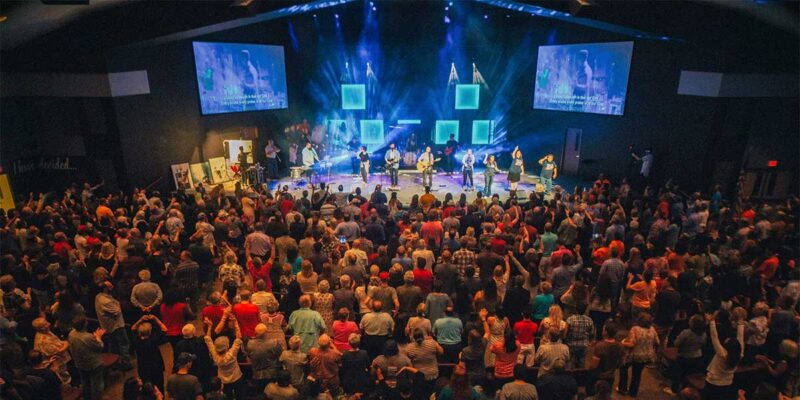Your Technology Is Not The Problem
 This year saw some of the best new technology breakthroughs in decades, but manufacturers and systems integrators still don’t understand why innovative gear fails to succeed in the house of worship market. It seems counter-intuitive, but approaching the top of the technology apex in audio, video and lighting isn’t generating the kind of sales one would expect from reaching new heights of technology innovation. The reason is the same as it’s always been in the technology sector: end user operators.
This year saw some of the best new technology breakthroughs in decades, but manufacturers and systems integrators still don’t understand why innovative gear fails to succeed in the house of worship market. It seems counter-intuitive, but approaching the top of the technology apex in audio, video and lighting isn’t generating the kind of sales one would expect from reaching new heights of technology innovation. The reason is the same as it’s always been in the technology sector: end user operators.
In a day and time where the transition from analog to digital is more complete than ever with the commercial roll-out of laser projection, LED fixtures for theatrical and architectural applications, and the deep lineup of completely digital audio systems, it would seem like the trifecta for unlimited sales. It’s not the gear, it’s the people. Always has been, always will be.
The Apex of Technology Meets the Under-trained Operator
Robert Scovill, an audio engineer that’s mixed for Journey, Tom Petty and a long list of others, also has experience in the HOW market. One of my favorite nuggets from Robert is this: “It’s not the quality of the tools, but the quality of the approach that counts.” While a certain level of natural talent and earned experience are integral parts of any technical operator, how they approach their job using technology is ultimately what makes the biggest difference in the outcome.
Church technical directors at some of the larger churches (nicknamed “mega churches,” and typically averaging over 2,000 attendees per weekend) often are skilled operators with previous experience, but the majority of churches are much smaller and rely upon volunteer technicians or contracted freelancers. In churches of all sizes, training is highly valued.
Currently, most manufacturer training is limited to the exclusive domain of rental and staging companies or systems integration employees. Church tech operators are frequently excluded from becoming certified in a particular technology because they’re not employed by a rental and staging or integration firm.
Why not provide that training beyond the firms to freelancers? This would create more qualified people running around knowing how to troubleshoot and do in-the-field fixes, which means more up-time for your device (proudly stamped with your company name all over it). And, the more qualified the operator, the better the performance of your technology in action. Heck, why not offer manufacturer-led end-user training for anyone willing to pay to become certified in operating and/or servicing your equipment — including church tech operators?
Design fees, installation labor, service contracts and rentals are good additional services and streams of revenue. In addition, the opportunity to sell training to churches — or even groups of churches at a time — is somehow still missing from the profit equation. By amortizing the cost of additional services through simple monthly payments on a training contract, churches often can afford the additional expense. Further, the ability to spread training out over a long period of time will yield both better consistency and a more satisfied client. These can even be use-it-or-lose-it contracts, meaning that the church leadership is more likely to ensure consistent participation so that their payment isn’t wasted. Manufacturers and integrators have got to think about how to provide real-world training to this vertical market.
Make the Case for Total Cost of Ownership
In the church space, a lot of attention has been focused on mission-critical, zero downtime technology. Sunday comes every seven days, and the tech has got to work each and every service. However, while uptime is an easy talking point the biggest sales tipping point today is Total Cost of Ownership (TCO). Like any other vertical market, HOW has certain consistencies of operation which make calculating hours of usage and maintenance downtime fairly easy to document. This is a significant advantage to manufacturers and systems integrators willing to spend time learning these variables for each church.
LED lighting has plenty of benefits – cool to the touch, low power consumption, long life spans – but until and unless those benefits are presented in the value proposition, including the TCO, the list is simply ‘cool’ (pun intended). In a typical large church, it’s reasonable to expect changing out incandescent theatrical lamps at least twice per year, and it’s also reasonable to assume there’s a man-power cost for re-lamping. But those costs are only part of the TCO, as the reduced heat of enough fixtures can actually affect the HVAC costs in certain facilities. Further, the low power footprint can also be calculated.
And while these represent cost savings, there are also some hidden costs that must be addressed in the same conversation. Namely, the change out of incandescent fixture dimming to LED dimming, as traditional dimmers will cause the LED fixtures to cut out when power dips below about 10 percent. It’s important that church leaders understand the entire changeover plan. Positioning the TCO as more than a cost offset for updating infrastructure is key, because churches will often either make these changes early on in the new year with new fiscal budgets or through a capital investment campaign for making improvements.
Similar to LED lighting are laser projectors; the cost savings of zero lamp replacements is a significant savings. The same TCO case can be made, so I won’t repeat the process here. The point is that with new innovations are new sales opportunities to present technology as both a bottom-line cost savings and offer better – and, hopefully, more consistent – results.
Audio isn’t immune from these innovations, but good technology in a bad room is still going to sound bad. As church technical director Warren Davis for a mega church in Lakeland, Florida says, “Any sound system needs three ingredients: good equipment, good acoustics, and a good operator. If any one of those ingredients is missing, the final result will suffer.”
Think Long Term
Both manufacturers and integrators need to look at each church as a long-term client. Sure, new technology helps today and may even address their top pain points, but it’s equally as important to evaluate their current technology and operations and talk about their five to 10 year vision and plan. The opportunity for selling scalable systems and repeat sales cycles is a reality in this market. Be a solution partner, not just a technology provider.
In the end, learn how to market and sell to churches in ways the identify these training and sales opportunities. Help churches make wise stewardship decisions beyond innovating technology; show them how to save money in the long run and train their technical operators on the very technology you sell them.
Do you see these opportunities the way Anthony does? What would you recommend? Comment below.





